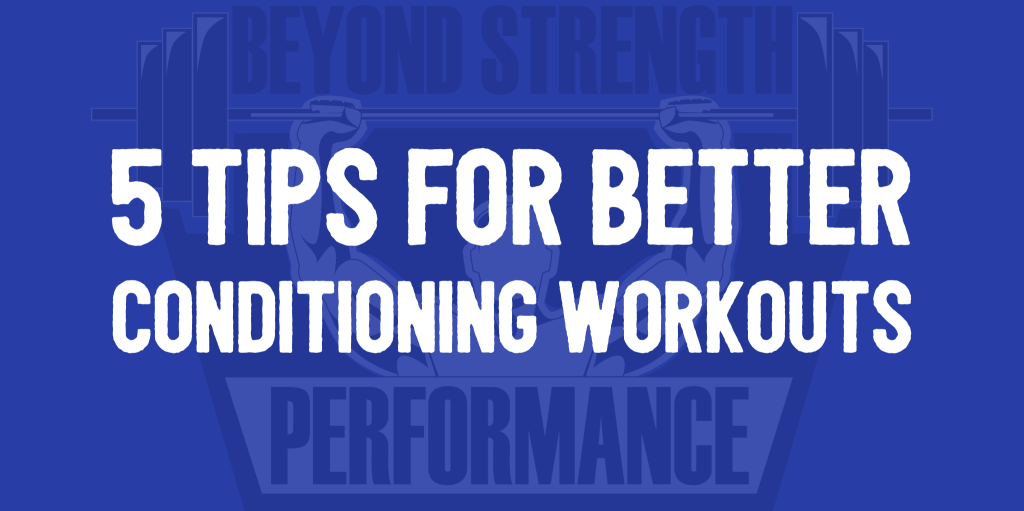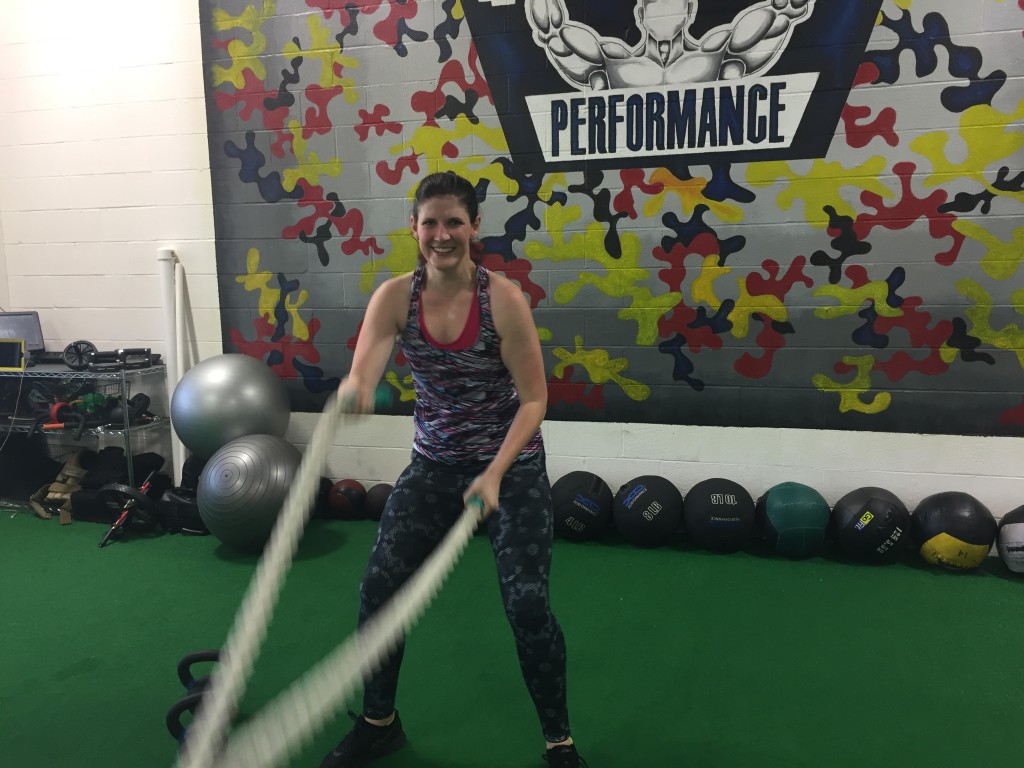
Thanks to gyms like Orange Theory and CrossFit, conditioning workouts are more popular than ever, and with good reason—the workouts are fun, focusing, and challenging. Conditioning, also commonly called cardio, is also a necessary component of any fat loss program. But, there are a few things that we need to consider before “letting it rip” with a conditioning workout.
We need to make sure that we get the most out of our conditioning workouts, as well as make sure we finish each workout injury-free.
To help you do just that, we’re sharing five tips that we use when writing conditioning workouts for our BSP NOVA members.
1) Fun, Fat Loss, Flexibility
 Fun, Fat Loss, Flexibility—those are the goals that each conditioning workout should aim for. Well, at least for most folks. If you have a specific performance goal—like competing in a triathlon or prepping for a specific sport—conditioning goals change. But for most folks, just training in order to live a better life, each conditioning workout should meet our three F’s.
Fun, Fat Loss, Flexibility—those are the goals that each conditioning workout should aim for. Well, at least for most folks. If you have a specific performance goal—like competing in a triathlon or prepping for a specific sport—conditioning goals change. But for most folks, just training in order to live a better life, each conditioning workout should meet our three F’s.
Fun—we all need to play more, because we need it; that’s right, adults need to play. Besides, with all the structure we all already have in our lives, sometimes it’s great to just cut loose and do something spontaneous. Here’s a little science for you folks that are interested. (If you’re not, you might want to skip the next few sentences.) Our brain craves novelty—it wants new problems to solve. That’s why we all started playing as children, our brains were seeking new things to understand. Play, in our case fun conditioning, helps us prepare for life’s chaos by putting us in novel situations that we have to figure out.
Also—fun is just, like, fun. So that’s pretty cool.
Fat loss—we all want to be lean and look good, right? At least we don’t know anyone that doesn’t want those things. Conditioning is important for fat loss because it trains our bodies to use stored energy. Think about it this way—training is all about telling your body to use fuel (e.g. food) in different ways, and conditioning is designed to help your body be more efficient in the way it does so.
Flexibility—we’re not talking about stretching. We’re talking about being prepared for different situations that life throws at us, and being able to handle a wide-range of stressors. You know, stuff like playing with your kids (or other people’s kids if you don’t have any), joining random dance mobs, joining your company sports team, fighting off a bear attack, or just generally having better cardiovascular and muscular fitness.
2) Vary Workout Intensity
 Not every conditioning workout should leave your body in the trashcan. While they should all be challenging in different ways, they all can’t be hard. And there is a sane and sound way to plan conditioning workouts throughout the week.
Not every conditioning workout should leave your body in the trashcan. While they should all be challenging in different ways, they all can’t be hard. And there is a sane and sound way to plan conditioning workouts throughout the week.
Early in the week, conditioning should challenge us with short, intense bouts of exercise followed by longer rest periods. Think trying to run inside when it starts pouring before you get soaked.
The middle of the week brings us longer bouts of exercise at a more moderate intensity. Think carrying lots of heavy groceries then jogging back to the car to get more. Like a lot of times.
At the end of the week we put the pedal down. Think someone just tried to take the last bit of your favorite Thanksgiving dish and you’re locked in mortal combat—the victor gets the last of the deep fried turkey! Don’t you dare lose!
We vary intensity in this way because it sets our bodies up for success by giving them the right amount of work at the right times. That means we’re able to recover from the training. Short, intense work at the beginning of the week is mostly easy to recover from. Moderate intensity in the middle of the week builds a little fatigue that helps our body change while still leaving room for recovery. And we pile it on at the end of the week because then we typically have a few days to recover from the beat down.
3) Move In All Directions!

Our bodies have evolved to bend, rotate, squat, push, pull, jump, run, stand on one leg, kick, punch, carry things, get down, get up, climb…and you know, lots of other things. We need to do a lot of those different movements on a weekly basis to keep our bodies moving well as we progress through life. So, rather than just hopping on a piece of cardio equipment and going at it for an hour, add more movement into your conditioning workouts.
4) Separate Lifting and Conditioning
Lifting heavy on the same day as an extended conditioning workout limits our ability to get the most out of both types of exercise. If you’re lifting on one day, it’s cool to add in a brief “finisher” that challenges your conditioning and cardiovascular system—but it shouldn’t take anymore than ten to fifteen minutes, and, in most cases, it should be shorter than that.
We only have so much energy to expend, and we want to give our bodies the best chance to accommodate the stress that we give to it—get stronger, get leaner, etc.—so we have to give it exercise in the right types and doses. Too much at once keeps the body from recovering. If we can’t recover from the exercise we do, our body sees it as too much stress and we actually get diminishing returns rather than the results we want, and that’s just not cool.
Like the idea of a “finisher?” Try this:
Battling Ropes ———— 3-4 x :15work/:30rest
alternating each set with
Skater Jumps ————- 3-4 x :15work/:30rest
5) Healthful Challenge
There’s a clichéd saying that bounces around on the internet—if it doesn’t challenge you, it doesn’t change you. It’s cliché, but, well, it’s kind of right. Training should make you a little uncomfortable. It should create an inner-dialogue that makes you ask some questions of yourself, and the answers to those questions should be a collective “push on.”
Here’s a challenge for you:
Set a stopwatch, pick up a pair of kettlebells, and make a challenge with yourself to see:
- a) far you can go
- b) how long you can go
Carry over 5:00? Go heavier next time. Under 5:00? Beat that time next week.
Revisit this from time to time, creating a little friendly competition with yourself—maybe even your friends.
We all need challenge—we are built for it. And when we overcome a challenge, even if it’s just a thirty second set of kettlebell swings, we prove to ourselves that we are tough, that we are strong, and that we can handle more in our lives. If your conditioning isn’t challenging you right now, it’s time for a change.
Take Action
Take these tips and get to work on your conditioning. And, if you want some help with that action, check out our conditioning classes. They’re laid out with these 5 tips in mind, and while we’re biased, we’d like to say they’re awesome. We’re kicking them off every Tuesday, Thursday, and Saturday, beginning with free preview classes Tuesday June 6th at 6am and 6pm.
Want to join us? Check out the event page here. (832)
Latest posts by Chris Merritt (see all)
- Why Your Favorite Instagram Model’s Butt Program is a Waste of Time - 2017/08/30
- The ABC’s of the Kettlebell Swing - 2017/08/23
- I’m New to the Gym, What Should I Do? - 2017/08/16
